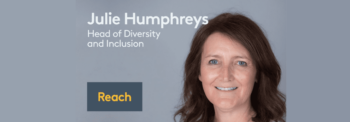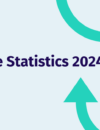
Interviewing Dr Julie Humphreys, Group Head of Diversity and Inclusion at Reach plc
We had the pleasure of catching up with Dr Julie Humphreys, Group Head of Diversity and Inclusion at Reach, to hear more about her role and the impact of diversity and inclusion initiatives in the publishing industry.
Please tell us about yourself and your role at Reach.
I’m Julie Humphreys, the Group Head of Diversity and Inclusion for Reach plc. Reach is the leading news publisher in the UK, with the largest portfolio of national, regional and local titles, including iconic brands such as the Mirror, the Express and OK!. We’ve got 5,000 employees and around some 48 million people a month in the UK choose Reach for their news, entertainment and sport.
What would you say is the media’s role in diversity and inclusion and how would you say it could improve?
From a diversity and inclusion (D&I) angle, there’s still a lot to be done within the publishing sector. I saw this as a real challenge when I joined the industry, and I really wanted to work with Reach to make change happen.
I think for starters, publishers need to be honest about the position of their companies right now, and begin from a place of learning rather than making knee-jerk reactions. It’s important to be clear about what your workforce really looks like, in order to put together an informed plan. So for example, during 2021 at Reach, our colleagues began sharing their personal information and their perceptions of inclusion that for 2022 – will give us a much better indication of where we are as an organisation.
It’s important to take a multilayered approach when addressing diversity and inclusion. At Reach, we’ve established a more inclusive hiring process and we’re mentoring and supporting the talent that we already have, in order to build a sustainable pipeline of diverse talent. But for change to really happen, everyone needs to be involved, and one of the ways we’re doing this is by providing our people with a robust platform for discussion around inclusion through our colleague networks.
Lastly, it’s helpful to work with external partners who have expertise and insights to share. We’re working closely with WeAreBlackJournos, the Women’s Sports Trust and PurpleSpace, to name a few.
What aspect of diversity and inclusion would you like to see more representation of and a wider part of the discussion?
To me, social mobility is key. It’s not covered by the Equality Act, but it’s a core part of our strategy here at Reach, as more and more companies are seeing the importance of considering socio-economic background. I’m proud that at Reach, we’ve created one of the first-ever employee networks, focussing on social mobility, called ReachPotential, and we’ve seen massive interest across our workforce to get involved with that network.
Do you think there’s a connection between the ethnicity pay gap and the gender pay gap? Do you think that the media and organisations are doing enough to report on both of them?
The last couple of years have really impacted organisations’ ability to report on pay gaps. Before the pandemic, organisations were talking about getting ready for the ethnicity pay gap and maybe even further, taking that to socio-economic pay gaps. It also looked like the government was about to encourage those. But then the pandemic hit. However, I’m really hopeful for 2022 though: companies will get back onto an even keel and start doing some really good quality reporting again.
How could someone take the steps to become a Diversity and Inclusion Officer or Head of Diversity and Inclusion?
There are lots of different routes. You could go through a HR pathway, with experience in recruiting, employee relations etc. Or you could volunteer in your company employee networks and get into a full-time role via that route. Another option is via work you may already be doing with charities that have a focus on underrepresented groups. There’s no real ‘right’ way to become a D&I professional. But, that’s the whole beauty of D&I – that we’re all different and we have different paths.
In your role or past roles, have you experienced any issues when it comes to budgeting, particularly regarding budgets being awarded to diversity and inclusion segments of an organisation?
Budgets are an interesting one. Essentially what D&I functions are trying to do is to support companies in becoming more inclusive – that does cost money, but it’s not always about how much you spend. At Reach, we go out into our local teams to talk about inclusion regularly, and that doesn’t cost anything. It’s about sharing the message and giving our colleagues the opportunity to influence our journey.
How do you tackle diversity and inclusion in such a large organisation? What kind of challenges do you face on a daily basis?
Scope is the largest challenge. You have to have a good plan and you have to have a strategy, but you also have to hear the voice of the people as well. It can never be a top-down approach, especially with an organisation of 5,000 people. In that scenario, there has to be a mechanism where everyone’s voices can be heard because all our contributions are important.
Have there been challenges in the diversity and inclusion function during the pandemic? What have been some of the positives that you’ve seen?
The pandemic has had a profound effect on business. For progressive companies like Reach, it has made D&I absolutely business-critical. Increased awareness of the realities of the pandemic for different groups really motivated people like never before; there was a significant shift in attitudes and focus across the business. I’m really hopeful that will lead to long-term, positive change.
For larger companies, how important would you say it is to have a designated diversity and inclusion department and how can separating HR from D&I benefit a business?
Here at Reach, I report directly into the CEO and I have direct access to the Board. In the past I’ve worked inside and alongside HR functions, and both can work well providing that there’s alignment with strategy. For D&I to make a difference, there are lots of elements and teams that need to come together such as procurement, communications, learning and development, HR data, employee relations, and HR business partners – not to mention recruitment!
So why was it really important to your CEO that a Head of Diversity and Inclusion be brought onboard to the organisation?
It’s no secret that greater diversity is good for business, but our CEO is passionate about wanting to make change beyond what’s good for business, which is inspiring. That’s why he made diversity and inclusion a stand-alone function, working through him as opposed to HR. It was the promise of a good partnership between us that got me really excited, I knew D&I was a priority at Reach and that change was going to happen.
What are some of the benefits of having direct communication with the CEO in regards to diversity and inclusion?
The big benefit is accountability and no blurred lines. We’ve got an open and honest line of communication. I know what Jim’s (Mullen) priorities are, and I know how to achieve them. I think this is the perfect world for a D&I Head to report directly to the CEO.
What kind of targets do you set within the diversity and inclusion team, if any?
I’ve noticed a real trend for targets in recent years across a number of organisations, but I worry that purely executive-led targets could lead to a disconnect with your people. At Reach, we were the first publisher to commit to the 30% Club targets at both Board and Executive Committee level and we’ve also developed Inclusion Action Plans for senior managers, so they have real ownership of their own goals. D&I shouldn’t be a top-down instruction; motivating your workforce so everyone is aligned on D&I is essential.
What do you think about the terms that we use for diversity and inclusion, and the power of language to impact our worldview?
Terminology has always been interesting for diversity and inclusion. Language is very emotive and ever-evolving. I think so many terminologies don’t explain the core of what diversity and inclusion really is. At Reach, we’ve completely reset and reframed diversity and inclusion based on feedback from our employees. Because of that, those words mean something. We’re clear that diversity is who we are and inclusion is what we do, and it’s as simple as that.
Tell us more about your experience of working with Druthers Search.
It was a great process. It was seamless and I received great feedback at every stage. I felt like I was talking to real professionals who knew and had understood and wanted to know more about diversity and inclusion.
You can connect with Julie on Twitter for updates about her work and more diversity and inclusion insights.
At Druthers, it’s our mission and our passion to empower organisations to find the best person to make an impact on their work, from a diverse shortlist of remarkable talent. Get in touch with us to find out how your business can make a positive change to your hiring and retention processes.





